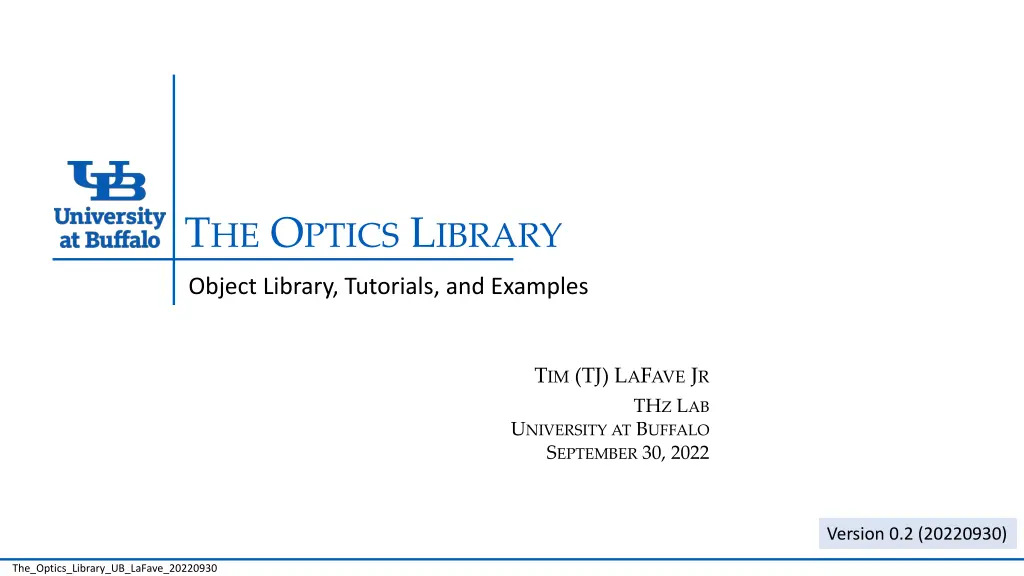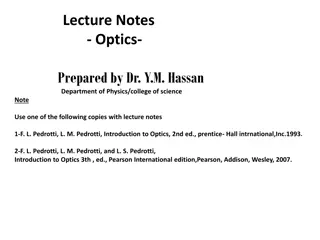
Optics Library Tutorials and Examples
Explore the diverse range of optics-related tutorials, examples, and resources available in The Optics Library at the University at Buffalo. Learn about creating figures, common optics blocks, detector orientations, and more. Enhance your knowledge and skills in the field of optics with this comprehensive library.
Download Presentation

Please find below an Image/Link to download the presentation.
The content on the website is provided AS IS for your information and personal use only. It may not be sold, licensed, or shared on other websites without obtaining consent from the author. If you encounter any issues during the download, it is possible that the publisher has removed the file from their server.
You are allowed to download the files provided on this website for personal or commercial use, subject to the condition that they are used lawfully. All files are the property of their respective owners.
The content on the website is provided AS IS for your information and personal use only. It may not be sold, licensed, or shared on other websites without obtaining consent from the author.
E N D
Presentation Transcript
THE OPTICS LIBRARY Object Library, Tutorials, and Examples TIM (TJ) LAFAVE JR THZ LAB UNIVERSITY AT BUFFALO SEPTEMBER 30, 2022 A picture containing text Description automatically generated Version 0.2 (20220930) A picture containing clock Description automatically generated The_Optics_Library_UB_LaFave_20220930 The Optics Library | markelz.physics.buffalo.edu | p 0
Table of Contents The Optics Library Instructions Tips & Tricks Create Figures from PowerPoint Objects Common Optics Blocks Balance Detector Orientations | No Txt Delay Stage Orientations | No Txt Examples Typical THz-TDS System Stationary Sample ATM (Two Orientations) Tip: Click logo on any page to return to Table of Contents. A picture containing text Description automatically generated A picture containing clock Description automatically generated The Optics Library | markelz.physics.buffalo.edu | p 1
The Optics Library | 0.75 Optics Lenses Apertures THz Polarizers Photoconductive Antennas EO Crystal Sample Microscope Objective Optical Fibers (w/ pigtails) Mirrors Beam splitters (Gold) VIS IR Parabolic Mirrors (90 Off-Axis) or Wollaston Prism THz Pellicles Lasers Fiber Couplers Beams Waveplates [beam] [fiber coupler] [pigtail-in optical fiber] THz Beams QWPs HWPs Example M1 M2 THz QWP Si Prism Miscellaneous (and In Development) Balanced Detector Spatial Light Modulators (binary) Fresnel Zone Plates Spatial Light Modulators (gradient) Choppers Pulse Shapes Shutter Delay Stage Beam stop A picture containing text Description automatically generated THz Buffalo A picture containing clock Description automatically generated The Optics Library | markelz.physics.buffalo.edu | p 2
Instructions | Tips and Tricks 1 Quickly place objects along a beam line (e.g. as shown at right). Highlight all the objects along the beamline, then on the Shape Format tab select Align >> Align Middle to vertically center them with respect to each other. Click on the parabolic mirror, then press and hold the left arrow key until it aligns with the diverging THz beam. Do the same with the PC Antenna until it aligns with the focus of the parabolic mirror on the THz beam. Next, left-click on the IR beam. Press and hold the SHIFT key, then left-click the right tick mark to drag it to the left edge of the THz antenna. Right-click the lens and select Bring to Front. Note: Using the SHIFT key when dragging objects restricts them to vertical and horizontal movements. This example set up a horizontal beamline that reflects into the ?-direction. See next page. A picture containing text Description automatically generated A picture containing clock Description automatically generated The Optics Library | markelz.physics.buffalo.edu | p 3
Instructions | Create Figures from PowerPoint Objects 1. Select all objects to the right. BS 2. Right-Click on one of the selected objects. 3. Click Save as Picture L1 L2 (?=25 mm) 4. In Save As Picture dialog box, select file format (?= 30 mm) NOTE: PNG for few-color image. JPG for many-color images. QWP 5. Type file name. 6. Navigate to appropriate directory. 7. Click Save. Transparent PNG | (Using Irfanview) The image here is a transparent PNG created from the objects above then converted using Irfanview. Professional Tip: Create Transparent PNGs Open the PNG file in IrfanView (recommended free app) Click File >> Save AS Select PNG as Save As Type. Check Save Transparent Color in Options window. Click Save. Move this image around to see the transparency. The little picture at bottom is the PNG saved with Powerpoint (no transparency) A picture containing text Description automatically generated A picture containing clock Description automatically generated The Optics Library | markelz.physics.buffalo.edu | p 4
Common Optics Blocks | Balanced Detector Orientations Bal. Det. Bal. Det. Wollaston Prism ?/4Wollaston Prism ?/4 M6 M6 M7 M7 M7 M7 Bal. Det. Bal. Det. M6 M6 Wollaston Prism Wollaston Prism ?/4 ?/4 ?/4 ?/4 Wollaston Prism Wollaston Prism Bal. Det. Bal. Det. M6 M6 M7 M7 A picture containing text Description automatically generated A picture containing clock Description automatically generated The Optics Library | markelz.physics.buffalo.edu | p 5
Common Optics Blocks | Balanced Detector Orientations (no TXT) A picture containing text Description automatically generated A picture containing clock Description automatically generated The Optics Library | markelz.physics.buffalo.edu | p 6
Common Optics Blocks | Delay Stage Orientations Delay Stage Delay Stage M3 M3 M2 M3 M2 M4 M3 M1 M2 M2 Delay Stage Delay Stage M4 M1 M1 M4 M3 M2 M1 M3 M4 M2 M2 M3 M3 M2 Delay Stage Delay Stage Delay Stage Delay Stage A picture containing text Description automatically generated A picture containing clock Description automatically generated The Optics Library | markelz.physics.buffalo.edu | p 7
Common Optics Blocks | Delay Stage Orientations (no TXT) A picture containing text Description automatically generated A picture containing clock Description automatically generated The Optics Library | markelz.physics.buffalo.edu | p 8
Example | Typical THz-TDS System PM3 PM2 EO Microscope Objective Antenna Crystal Sample Pellicle M10 M7 PM4 PM1 ?/4 M2 M5 PBS M6 Wollaston Prism Delay Stage ?/2 M4 M3 Bal. Det. M8 Ti:Sapph Laser (?=800 nm) M1 M9 FIGURE. A typical THz time domain spectroscopy (THz-TDS) system. HWP=Half waveplate, PBS=polarizing beamsplitter, M=mirror, PCA= photoconductive antenna, PM=parabolic mirror, QWP=quarter waveplate. Currently shown on Wikipedia: https://en.wikipedia.org/wiki/Terahertz_time-domain_spectroscopy A picture containing text Description automatically generated A picture containing clock Description automatically generated The Optics Library | markelz.physics.buffalo.edu | p 9
Instructions | Create Figures from PowerPoint Objects A picture containing text Description automatically generated A picture containing clock Description automatically generated The Optics Library | markelz.physics.buffalo.edu | p 10






















